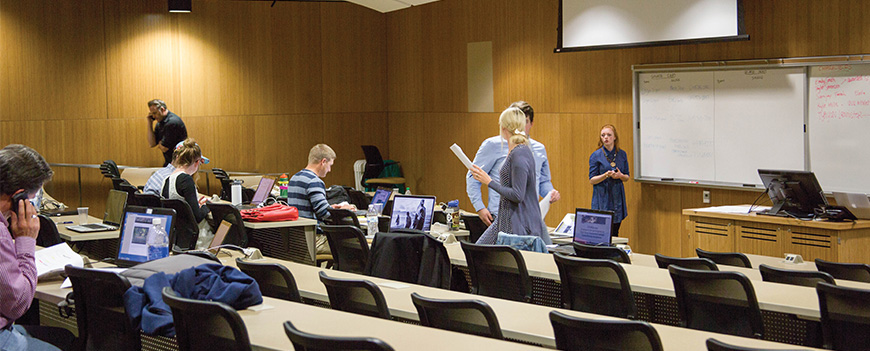Students learn what it takes to be CommStrong
“I didn’t know what I was getting into,” said Aubri Liechty, a sophomore in English, as she reflected on her experience with the eight-hour event of CommStrong.
On Friday, students in the department of journalism and communications prepared for CommStrong, a simulated crisis to test their patience and skills in leadership and communication.
Professor Matthew LaPlante spearheaded this event with two student co-directors, Brooke Leavitt and Seth Merrill, both seniors majoring in journalism.
“Everybody fails,” LaPlante said as he explained the purpose of CommStrong. “Nobody succeeds in CommStrong. … The learning is in the failure.”
This was the fourth consecutive year of the event, but the first to be held in the evening. Students in LaPlante’s Global Crisis Communications and Intro to News Writing classes were placed into teams with two team leaders. These groups represented printed and online newspapers, public relations teams and a TV broadcast team. The students were then presented with various crises and were expected to deal with them as though they were real-world events.
Volunteers from various facets of Utah State University came together to represent individuals in the simulation. Kristine Peatross, a sophomore majoring in landscape architecture, volunteered as a character, or shadow player.
“I’m supposed to be a team member of this guy who got injured. … I’m supposed to call and be angry,” Peatross said.
These volunteers collaborated in what was called the War Room. Everyone was on a cellular device or computer playing a different role. Peatross said this component was “pretty fun.” The planning committee gave participants two phone numbers to call as “information hotlines.” However, there was a typo in one, and someone with a Utah number received more than 40 calls that he thought were “prank calls.” One student was forced to break character and alert organizers of the error, and teams were informed not to use it.
“They’re actually acting and engaged in what is going on,” LaPlante said. “When you’re in it, it feels real.”
The preparation for CommStrong entailed written scripts for each volunteer as well as the set-up technology, ranging from computers to cameras.
LaPlante expressed the importance of the students being able to communicate with each other while still being insulated from the outside world. Every faux news organization participating had its own website, Twitter page and email address.
“Until you really stress them out and exhaust them and overwhelm them, there is no way for them to know how they will respond in a real-world situation, which means there’s no way for them to train for that,” LaPlante said.
Ethan Trunnell, a sophomore majoring in English, is in LaPlante’s news writing class and explained his motivation for participating in CommStrong.
“He offered us 20 points of extra credit, which — if you’ve never been in that class — is kind of a big deal,” Trunnell said.
Sadie Hughes, a freshman majoring in English, expressed her emotions before the event.
“I’m so nervous. … I’m pretty scared,” Hughes said.
The teams had to be judicial with the stories they chose to pursue. Red herrings, or insignificant stories, were thrown into the mix with large-scale crises.
“It was hard to stay focused and decide what was important,” Hughes said.
I learned a lot about prioritizing.”
After the eight hours, Trunnell reflected on his experience, calling it a “roller coaster.”
“You really have to check your facts,” Hughes said. “The first guideline of journalism is to seek truth and report it, and I think that’s the most important thing, to make sure you’re getting information from reliable sources. … It was really frustrating. … You were never sure if information was reliable.”
Trunnell said that working with people on the phone was “almost like dealing with people in a customer service job.”
Leavitt, the student co-director, commented on the effectiveness of the exercise.
“We did what we wanted to do, which was get them stressed out,” Leavitt said, “and try for each of them to see how they react in stressful situations.”
The learning was individually focused. Students were given an opportunity to see how they personally react in a crisis and how to prepare for them.
“I think it’s a really good learning experience,” Liechty said. “Being a team is probably the most important thing.”
Hughes chuckled at her experience.
“It was good,” she said. “At the end, LaPlante just kind of told us how the simulation was kind of to make us feel like we failed, and — according to that — it worked.”
— abbywalker825@gmail.com

